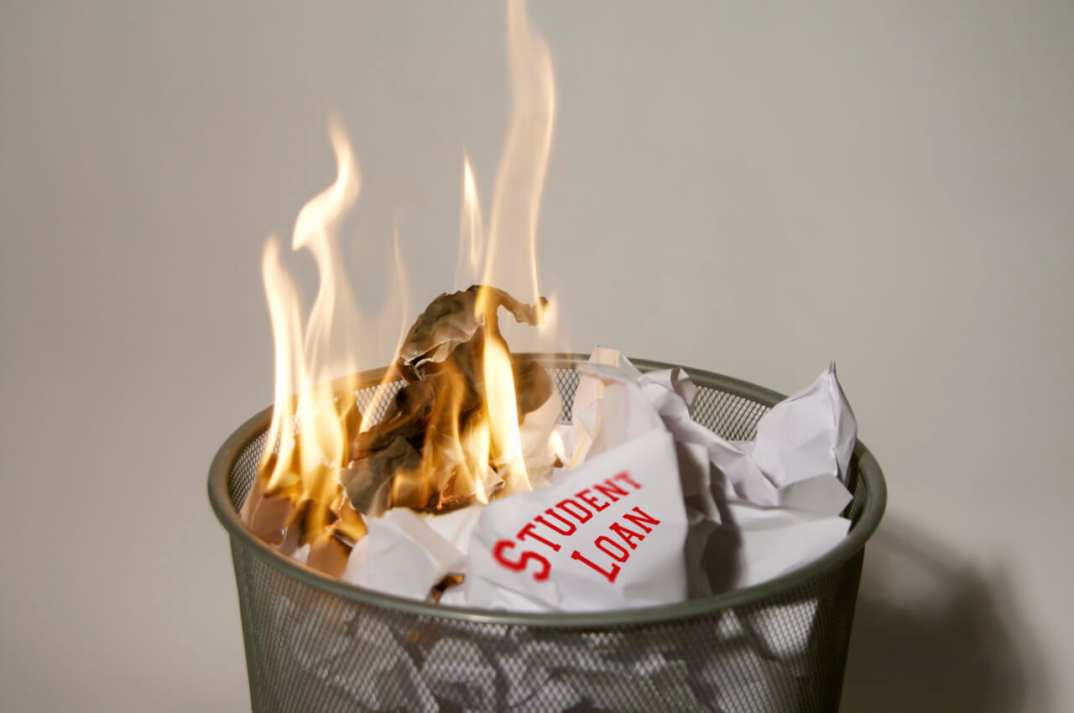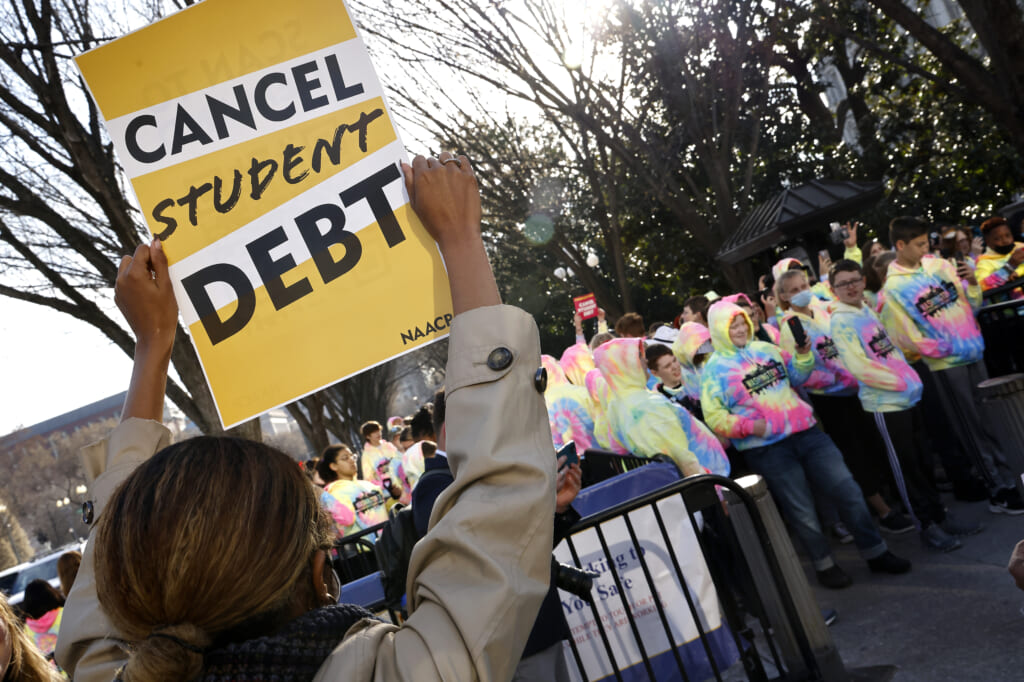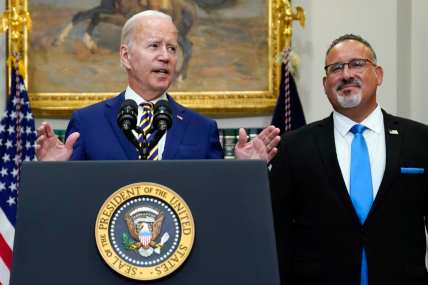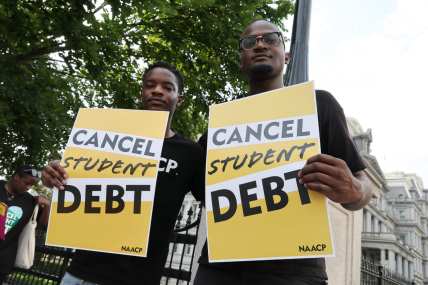The top 10 arguments against student debt relief (and why they’re wrong)
OPINION: While most of the common objections to student debt relief don’t hold up when facts and logic are applied, there is one that can’t be dismantled.

Editor’s note: The following article is an op-ed, and the views expressed are the author’s own. Read more opinions on theGrio
The Biden administration’s landmark student loan forgiveness plan has sparked a furious debate on both sides of the issue.
Unlike most political policies, the opposition or support of student debt relief isn’t necessarily split between people who cry themselves to sleep over global warming vs. people who want to padlock women’s vaginas until Jesus gives white state legislators the key. While those who have been crippled by student debt are celebrating like it’s student loan Mardi Gras, people who don’t care about the crippling effects of student debt have offered a number of talking points to undermine the logic of debt relief.
Of course, these talking points are usually riddled with logic-deficient holes, but just for fun, let’s look at the most common arguments from people opposed to student debt relief and see why they’re almost all wrong.
10. It’s unfair to people who worked hard to pay off their student debt.
You’re right.
Unfortunately, the U.S. Constitution doesn’t give the president, Congress or the Supreme Court control of the space-time continuum. If I had my choice, I’d send Joe Biden back into time to drill a hole in the Portuguese vessels that started the trans-Atlantic slave trade, avert Reconstruction by warning Congress about the ramifications of the Compromise of 1877 and then repay all student loans. However, since the world’s most outstanding scientists and engineers are slacking on their time-machine construction, lawmakers are forced to address the debt crisis the same way every human being on the planet has always solved problems—by fixing the problem that exists in the present.
Using this logic, there are a host of other things that are unfair. Ending slavery with the 13th Amendment was unfair to the people who risked their lives to escape slavery. The Voting Rights Act was unfair to all the Black people who endured racial terrorism and election violence to vote in elections prior to 1965. The concept of Christianity is unfair to all those scapegoats that were sacrificed before Jesus died on the cross.
Of course, it would probably be fairer if the government went back and compensated people who didn’t benefit from the work and money they invested into America’s economic stability.
Too bad no one has ever thought about that.
9. Student debt relief is too expensive. Where will we get the money?
This one’s easy—stop funding white privilege.
While the White House estimates that the current proposal will cost $240 billion over 10 years, the Wharton School estimates the cost could rise up to $517 billion. Let’s suppose the experts at Wharton know what they’re talking about. After all, the institution has produced noted economic geniuses such as six-time bankruptcy filer Donald Trump. Even if we broke the payments down equally (anyone with a student loan payment knows this is wishful thinking), we don’t have to have a national bake sale.
Here is a list of ways that we can make $51.7 billion per year if we just stopped giving white people a free ride.
- White farmers: The 2018 Farm Act’s $428 billion over five years doesn’t include the $9.7 billion in pandemic relief funds, nearly 97 percent of which went to white farmers or the 99 percent of the trade war billions that went to white farmers. Almost all farm relief goes to white farmers. Meanwhile, Black farmers haven’t received their share of COVID funding because white farmers said it was reverse racism.
- The criminal justice system: We spend an estimated $81 billion on prisons per year. Even if you are not an abolitionist, you could dramatically lower the cost of mass incarceration by simply policing, arresting and sentencing nonviolent Black offenders at the same rate as the white ones.
- Killing machines: Lowering the proposed $773 billion defense budget conjures up images of brave soldiers wearing Wrangler jeans fighting with muskets and pocketknives. But most of that money goes to private companies, and 90 percent of government contracts go to companies owned by white men. In 2020, we handed $166 billion taxpayer dollars to five military contractors. We should adhere to the principles of the conservatives who bellow endlessly about the “free market” and force these companies to give us a discount. What are they gonna do, award the contracts to someone else?
- Rich freeloaders: According to a report by the Tax Justice Network, tax abuse and avoidance by corporations and wealthy individuals cost the U.S. government an estimated $89 billion every year. In 2020, At least 55 of the largest corporations in America paid no corporate income tax, dodging $12 billion in tax dollars. In 2021, 92.6 percent of fortune 500 CEOs were white.
8. It’ll go to wealthy, white people.
Not exactly.
According to Aaron Sojourner, a labor economist with the Upjohn Institute, 34 percent of Americans who borrowed over the last decade didn’t get a degree at all, 11 percent graduated from a two-year program and 10 percent received a professional certificate. Furthermore, 90 percent of the people who benefit from Biden’s plan make less than $75,000 per year.

Because there are more white people, they make up the majority of student loan debtors (55 percent of student loans go to white people). However, a larger percentage of Black students borrow money for college, are behind on their payments and eventually default on student loans, according to the Education Data Initiative. In fact, most Black borrowers still owe 95 percent of their student loan 20 years after starting college, compared to 6 percent of white borrowers.
7. Maybe they should be more financially responsible.
This is one of my favorites. A lot of people believe they avoided poverty because they are smarter, work harder and plan ahead. Take the now-deleted tweet from Boston University theology professor David Decosimo, who contends that people who aren’t in debt simply make better choices.
“Support cancelling [sic] student loan debt if you like but don’t claim for a second to be progressive, for the poor, on the side of workers, lol,” he said whitely, while probably hog tying a woman to railroad tracks. “Go tell someone who pursued a trade, chose a cheap school, or joined the army how their your paying your NYU debt is actually solidarity, comrade.”
Actually, one-third of America’s military forces and approximately 200,000 active duty military members owe a collective $2.9 billion in student loan debt. The high default rate among Black student borrowers has less to do with financial responsibility than the fact that Black graduates have less wealth, are paid less and are saddled with higher interest rates.
Yet people like Decosimo genuinely believe that financial hardship is a result of choices because their privilege won’t allow them to believe that intergenerational economic mobility is a result of race, privilege and people like David Decosimo not giving a…
6. We should make people pay their debts, not incentivize them to abdicate their financial responsibilities.
Good point. Now do the same for corporations who avoid paying taxes. Do it for all of the white-owned businesses that received PPP loans and then had them forgiven. Don’t forget the auto industry, the financial institutions and the other corporations that receive government bailouts.
Now do the entire federal government.
5. Loan forgiveness is socialist, a massive transfer of wealth or a government handout.
Yes, it is.
Remember what we said about white farmers receiving government handouts? How about those socialist PPP loans? The New Deal was also a massive transfer of wealth, but it only went to white people.
Historically, U.S. economic policy has always been a massive transfer of wealth from Black people to white people. Race-based, constitutionally enshrined human trafficking was an enormous transfer of wealth. Headrights were, too. So were segregation, slavery, Native American land theft, Jim Crow and racial real estate covenants. So are mortgage lending, car loans, credit ratings, school funding and the entire university system.
Only two state university systems (West Virginia and New Mexico) in the country reflect the demographics of the taxpayers who fund them. Every major financial institution has been sued for discriminating against Black borrowers who partly pay the taxes that fund the FDIC and bail out banks. Rich parents can transfer wealth to their children without consequence, while poor parents have to borrow their tax money to pay their kids’ college tuition.

The idea of a “government handout” ignores the fact that it is our money. We are the government. We paid those taxes. Yet, for some reason, using our money only becomes a problem when we might transfer wealth to non-white, non-wealthy people.
4. If you can’t afford college, you should take on a trade or go to community college.
Why do people believe learning a “trade” is free?
Is there someplace where they stick a needle in 18-year-old high school graduates’ heads and infuse them with the ability to repair air conditions or rebuild alternators? There’s a whole segment of schools, “trade schools” and—news flash—they charge tuition. Even though they are less expensive, students still have to borrow money to attend trade school.
On average, a trade school education costs $33,000 and, since most 18-year-olds don’t have 30 grand stuffed under their mattresses, they have to borrow money. Students graduating from two-year and vocational colleges average $10,000 in student debt and have default rates similar to four-year grads. The average community college debt for graduating students is $13,000.
3. Why should my tax money be used to pay for other people’s debts?
This is a big one. Take this tweet by high-school dropout, criminal justice insider and the most uneducated member of Congress, Rep. Lauren Boebert.
I don’t know if Boebert knows this, but this is how societies work.
Your tax money is used to fund your local school system even if you send your children to private school. Your state taxes maintain and repair roads on which you will never drive. If your house doesn’t burst into flames, you don’t get a refund for the part of your local taxes that goes to the fire department. However, you will still benefit.
Your property value would decrease if every other lot held the charred remains of a burned home. You don’t have to drive 20 miles to the grocery store because your city taxes are used to plan and maintain commercial districts. Your car insurance rate partly reflects the rate of car accidents and claims caused by bad roads.
And yes, more educated communities have lower rates of unemployment rates, poverty and crime. So the choice is yours. You can fund prisons or student debt forgiveness. You can choose low property taxes or lower wages. You can pay for welfare programs, broken windows, police protection and unsafe neighborhoods, or you can help create a fairer, more prosperous, more equitable society.
Either way, you are going to pay.
2. Paying off student debt doesn’t solve the problem.
This is correct. We can’t solve the skyrocketing costs of college tuition by ignoring debt and asking others to pay the debt of those who are financially irresponsible. And a measly $20,000 doesn’t help people who owe hundreds of thousands. We should actually pay more. However, there is a part of the problem that hasn’t been plastered across headlines. There is a group that has been financially irresponsible and is asking other people to help them pay their debt.
Colleges.
Collectively, America’s colleges and universities are $240 billion in debt, including a staggering total of $145 billion in the last five years at public universities. At institutions of higher learning across America, an average of 9 percent of the budget is dedicated to servicing debt—the equivalent of $750 per student per year at public universities. And to solve this debt crisis, these schools raise tuition, which forces students to borrow money from the government to attend the colleges that are already funded by taxpayers.
To be fair, this isn’t the only way these colleges are paying their debts. Many public colleges also issue tax-free municipal bonds through state and local governments that allow investors to earn untaxed profit from publicly funded colleges. And after they collect their earnings from taxpayer-funded schools, the investors turn around and complain about their tax dollars going to the people who had to borrow money to line their overstuffed pockets.
It’s a great scam.
But sure, go ahead and complain about financial responsibility and paying off someone’s debts.
1. I don’t care about people.
I can’t argue with that one.

Michael Harriot is a writer, cultural critic and championship-level Spades player. His book, Black AF History: The Unwhitewashed Story of America, will be released in 2022.
TheGrio is FREE on your TV via Apple TV, Amazon Fire, Roku, and Android TV. Please download theGrio mobile apps today!


